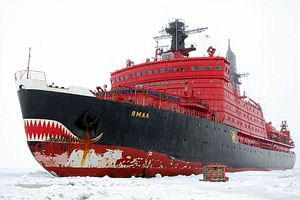Last week, Russia floated its first new military icebreaker in half a century, TASS news agency reports. The 6,000-ton Project 21180 diesel-electric icebreaker Ilya Muromets was launched during a ceremony held at the Admiralty Wharves Shipyard in St. Petersburg on June 10.
The Ilya Muromets is expected to be inducted into the Russian Navy in 2017, the CEO of the Admiralty Wharves Shipyard, Alexander Buzakov, said during the ceremony. “Today, after a five-year break, we’re floating out a new vessel – a supply ice-breaker with large functional capabilities. Symbolically, the nuclear-powered ice-breaker Lenin was laid down at this slipway 60 years ago,” Buzakov added.
Furthermore, Buzakov said that in 2016 “new ships will be laid down at this slipway for their use in the Arctic zone.” Two arctic corvettes, armed with cruise missiles, capable of acting as icebreakers are expected to enter service with the Russian Navy by 2020.
Russia operates a fleet of 40 icebreakers and is working on adding about a dozen new ships over the next couple of years. I explained previously (See: “Russia and China in the Arctic: Is the US Facing an Icebreaker Gap?”):
Out of the 40 around 27 are ocean-going icebreakers, some of which are nuclear-powered. Russia is also planning to introduce a new class of super-nuclear icebreakers, by the end of 2020. According to Russian Deputy Defense Minister Dmitry Rogozin, the layout of the new vessel, purportedly capable of cutting through 13-feet-thick ice sheets, will be presented by the end of 2015.
The Ilya Muromets could be the lead ship of a new class of icebreakers, depending on how well the vessel will do perform in service. The 6,000-ton ship is 85-meter (280-feet) long and can purportedly break through a meter of ice. It can traverse the entire 5,600 kilometer (3,500 mile) length of the Northern Passage and can operate autonomously for up to 60 days, according to Russia’s Ministry of Defense. The icebreaker will have a crew of 35.
As I explained in January, (See: “Russia and China in the Arctic: Is the US Facing an Icebreaker Gap?”), the United States is facing a shortage in Arctic icebreakers:
The United States currently operates two polar icebreakers: the Polar Star and the Healy. However, only the Polar Star is a heavy icebreaker capable of accessing all of the Arctic year-round. (The Polar Star’s sister ship, the Polar Sea, had a major engine breakdown in 2010 and has not been operational ever since.) Furthermore, the Polar Star, commissioned in 1976, is slated to reach the end of its operational lifespan in 2020.
As a consequence, the White House pledged its support in helping acquire additional ships in September 2015. There are, however, two major obstacles that first need to be overcome as I noted:
First, it [the U.S. Government] would need to find a way to circumvent the standard acquisition approach that would take the Coast Guard about ten years to build a new ship. (…) Second, the U.S. Coast Guard is facing severe budgetary constraints. The money ($1 billion) it would need to kick-start the development and construction of a new icebreaker is equivalent to the entire acquisitions budget of the Coast Guard for 2015, and it is highly unlikely that the service branch will receive additional funds in fiscal year 2016.
Russia, meanwhile, is planning to expand the number of its Arctic military bases and is even considering re-establishing an Arctic air force. In fact, the increase in the number of Russian military bases in the Arctic is one reason for the expansion of Russia’s icebreaker fleet, given that most supplies to the new outposts need to be ferried aboard icebreakers.
































